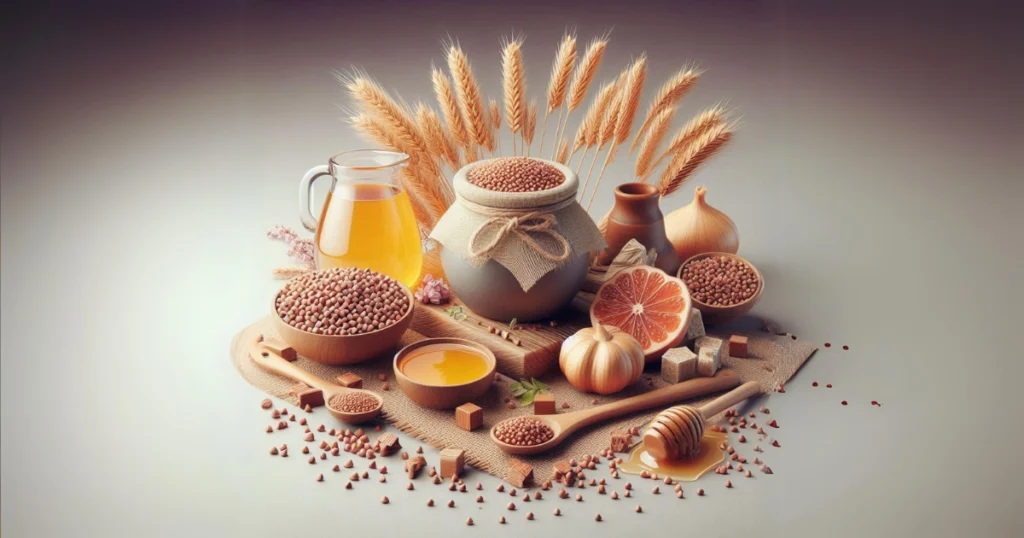
Bees collect nectar from buckwheat blooms to produce buckwheat honey, a highly nutritious honey. Buckwheat has tiny blossoms; therefore, bees that make buckwheat honey have to work harder to collect enough nectar.
Commonly used as a flour alternative, buckwheat is not a grass like wheat. It actually produces fruit that is comparable to rhubarb.
Buckwheat honey is less sweet than regular honey. Its higher antioxidant content may make it healthier than sweeter honey. Buckwheat is high in vitamins and considered a very nutritious meal; therefore, it stands to reason that buckwheat honey would be beneficial to your health.
Buckwheat honey’s color can vary from dark purple to black. Overall, it appears to be your typical amber-colored honey with a faint reddish tint. Buckwheat blossoms are often dark in color, which contributes to the rich hue of buckwheat honey.
Benefits of buckwheat honey
Buckwheat honey’s key benefits include promoting healing in the body, supporting immunological function, and increasing antioxidant levels. It is also effective for relieving sore throats and coughs. Some people even use honey as part of their skincare routine. Studies have also demonstrated the ability of buckwheat honey to assist diabetics in controlling their blood sugar levels.
Many studies have demonstrated the benefits of honey. Research has shown that buckwheat honey, in particular, offers numerous health advantages, including:
Increasing antioxidants
One study discovered that ingesting buckwheat honey mixed with black tea greatly increased the body’s antioxidant levels. Another study ranked buckwheat honey very high in antioxidant status among available honeys on the market.
- Wound care: Studies have shown that honey effectively removes moisture from wounds and aids in the removal of bacteria. Honey, due to its high sugar content and low pH, can help inhibit the growth of bacteria and other germs in the wound.
- Skin care: We need more research to pinpoint the specific advantages of using honey for skin care. Honey generally preserves and moisturizes your skin. Look for honey-based skin care products, or make your own moisturizer by combining coconut oil and honey in an electric mixer until it resembles whipped cream.
- Preventing DNA mutations: Studies have even shown that certain honey varieties can help correct DNA changes that cause disease and cancer.
- Reducing cholesterol: Research has demonstrated that buckwheat honey can lower blood cholesterol levels, thereby promoting heart health and potentially lowering high blood pressure.
- Soothing cough: One study specifically examined the use of buckwheat honey as a therapy for nighttime coughs in children caused by respiratory infections such as colds. The researchers discovered that buckwheat honey was more effective than over-the-counter cough medication.
How to use buckwheat honey
The way you use buckwheat honey depends on what you’re attempting to treat.
Apply raw honey directly to the wound and wrap it in a clean bandage.
You can take honey by the tablespoon as a general health supplement or combine it with your favorite dish or beverage. Buckwheat honey is an excellent natural sweetener for any meal or dessert. You may include it in oatmeal, pancakes, waffles, smoothies, and baked products; the options are limitless.
You can swallow honey alone or mix it into a warm herbal tea to relieve sore throats and colds. The American Academy of Family Physicians recommends treating a child with a cold with a single dose of honey in the following amounts:
- Children aged 2 to 5 require 2.5 mL.
- Children aged 6 to 11 need 5 mL.
- Children aged 12 to 18 need 10 mL.
As with all honey, avoid giving buckwheat honey to infants under one year old. Honey contains microorganisms that may be harmful to infants.
The bottom line
Buckwheat honey has a variety of health benefits. It’s also a delicious sweetener. You can best purchase Buckwheat honey from a local farm, beekeeper, or farmer’s market.


